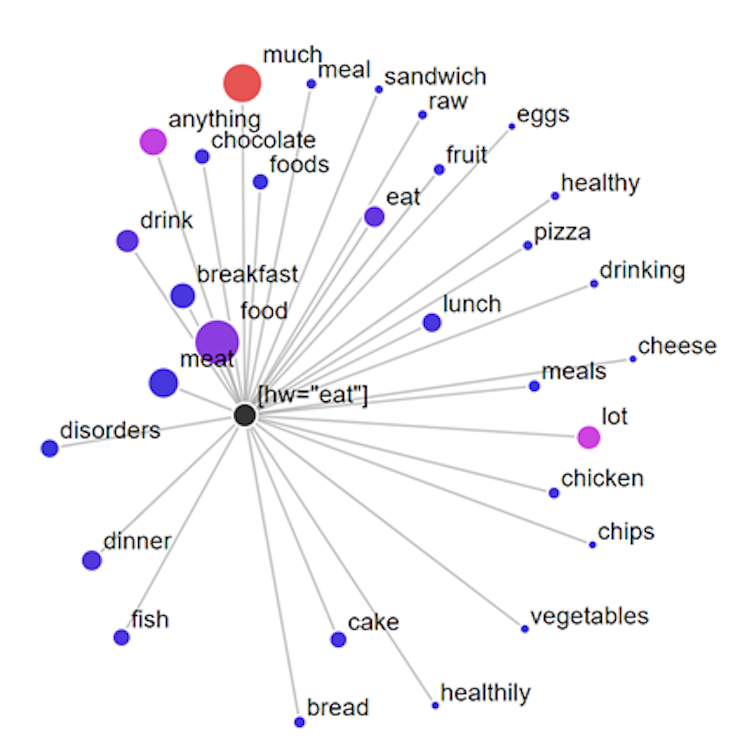Lovely weather today, isn’t it? Time for a cuppa? The way someone talks, and the words they use, tell us quite a bit about where someone is from, their social background and even their age. Language both reflects and shapes society – as a linguist, it’s my job to find out how.
One way to do this is by analysing large collections of language, which linguists call corpora (or “bodies”). By measuring the frequency of words, we can determine what a particular society or group prioritises and values.
In research for a new frequency dictionary of British English, my colleague Dana Gablasova and I, both at Lancaster University, analysed every word in the British National Corpus 2014.
The corpus is a 100 million-word sample of current language. It covers language used in informal speech, fiction, newspapers, magazines, academic writing and online sources between 2010 and 2020. It is free and publicly accessible at #LancsBox and LancsLex. Here are five frequently discussed topics and some of the words that define them, including how many times they appeared per million words.
1. Time and punctuality
According to our analysis, “year” and “time” are the two most frequent nouns in British English, occurring 1,963 and 1,898 per million words, respectively. People talk and write about them all year round, time (and time) again. The idea of time is closely connected with punctuality – something highly valued in Britain.
The expressions “on time” and “in time” occur with the combined frequency of 47 per million words. When we look at preferences of individual time-related words, summer (144 per million) is preferred over winter (63 per million). Sunday (114 per million) and Saturday (104 per million) are spoken and written about more than any of the other days. Morning (206 per million) is twice as frequent as evening (103 per million) and almost three times as frequent as afternoon (70 per million). The most popular month is December (149 per million), followed by March and May (145 and 142 per million respectively).
2. Weather and climate
Cultural stereotypes – and plenty of polling – suggest that Brits frequently talk about the weather. Our language data supports this.
The word “weather” occurs with the frequency of 60 per million, alongside words such as “pub” and “restaurant”, which occur with similar frequencies. “Weather” is most frequently used in online language (mainly emails and text messages) followed by newspapers (weather reports).
Here is an example from the corpus of a casual exchange of text messages showing a typical weather small talk:
Vaclav Brezina, Author provided (no reuse)
Looking at specific weather terms, people more frequently talk about the sun (91 per million) than the rain (51 per million as a noun, and 15 per million as a verb). Storms (32 per million), clouds (39 per million), floods (19 per million) and even snow (37 per million) receive their due share of attention in texts and conversations. Major storms are often referred to by their names, such as Desmond, which caused extensive flooding in 2015.
Climate change (29 per million), emissions (43 per million) and renewable energy (6 per million) also now dominate the public discourse, indicating a growing focus on longer-term changes, not just current weather conditions. There has been a 21% increase in the combined relative frequencies of these terms between 2010-2015 and 2016-2020.
3. Food and drink
This category reflects eating and drinking habits as well as dietary preferences. “Dinner” appears 68 times per million words, “lunch” 51 times and “breakfast” 43 times per million. The most frequently mentioned food items include eggs, fish, cake, apples, chocolate, cream, chicken, meat, fruit and cheese. And a cultural sweet tooth is evident: cake is spoken about three times more frequently than salad.
The most commonly mentioned beverages include: tea, wine, coffee, beer, milk, juice and champagne. The quintessentially British beverage, tea, is almost six times more frequent than champagne.
The graph below shows what words are prominently associated with the verb “to eat”. We measured these to show how strongly the words are connected in text and speech. The closer the word appears to the node in the middle, the stronger the association – and the size of the circle reflects the frequency of these words appearing together in texts and speech.

Author
4. Emotions
Keep calm and carry on? While the British disposition is known to be composed and slightly reserved, the data shows that the most frequent adjective expressing an emotion is “happy”. It occurs 208 times per million, often used in phrases expressing contentment, such as “I’m quite happy to stay at home”.
In contrast, the most frequent adjective expressing a negative emotion is “sorry” (204 per million), often used in apologies or polite refusals. Other adjectives expressing emotions include proud, sad (both 54 per million), pleased (53 per million), afraid (47 per million) and glad (46 per million).
5. Our bodies
The review of the British National Corpus 2014 also shows that people spend quite a bit of time talking about their bodies. Specifically, hand, head, eye, foot and heart are the top five most frequently used words referring to our body.
Many uses of words in this category are metaphors or a part of fixed expressions. About one third of uses of the term “head” are metaphorical or have another meaning, such as a job title: “head of marketing”. Expressions such as “on the one hand”, “in the public eye”, “put one’s foot down” and “break somebody’s heart” are all examples of how our bodily experience of the world is present in ordinary language as we use it every day.



